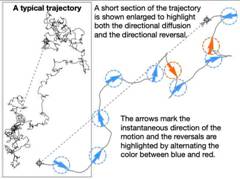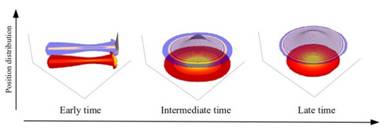Ministry of Science & Technology
New theoretical explanation for a unique reversing motion of bacteria can help building more efficient artificial micro and nano-motors
प्रविष्टि तिथि:
30 JUL 2021 4:15PM by PIB Delhi
In a recent study, Indian Scientists have found a theoretical model explaining a unique kind of motion called direction reversing active motion exhibited by some bacteria that feed on other microorganisms. This analysis can help in building more efficient artificial micro and nano-motors used in drug delivery and bio-imaging using the concept to incorporate a reverse gear.
Bacteria move by propelling themselves with a velocity that changes direction randomly, which is called active motion. Besides bacterial motion, this kind of motion is found in living systems ranging from cell motility at the microscopic scale to the flocking of birds and fish schools at the macroscopic scale as well as in artificial systems including granular matter self-catalytic swimmers, and nano-motors. It forms an important sub-set of the ubiquitous nonequilibrium systems, for which no general theoretical framework exists. Some microorganisms, such as predator bacteria Myxococcus Xanthus and saprotrophic bacteria Pseudomonas putida, exhibit a unique kind of reversing active motion, whereby, in addition to a diffusive change of direction, the motion also completely reverses its direction intermittently. However, very little has been understood theoretically about the statistical properties of such motion.
In a recent study published as a Letter in the Physical Review E, a team of Scientists from Raman Research Institute and S.N. Bose National Centre for Basic Sciences, autonomous institutes under the Department of Science & Technology (DST), GoI has uncovered novel dynamical phases arising from the interplay of diffusion and velocity reversal in the direction reversing active motion exhibited by such bacteria.
The study provided a theoretical understanding of such motion through exact analytical results for the position distribution and target search-time distribution by using a model. “This model explains the advantage of directional reversals, namely, faster spread leading to faster searches,” the authors pointed out. They explained how their research found that M. Xanthus relies on the directional reversal to increase its spread, thus making search for a target efficient, inspite of a much slower speed (about a micron per minute) compared to faster bacteria like E. coli ( moves about thirty microns in a second). Further, the most important finding of this work is the prediction of a novel phase where the dynamical laws governing the dispersion along two orthogonal directions are fundamentally different.
The theoretical analysis of the direction reversing active motion, starting from the microscopic dynamics partially funded by the Science and Engineering Research Board (SERB), India, under Ramanujan Fellowship, will serve as a building block for biologists and experimental physicists studying other complex phenomena shown by direction reversing bacteria.
Publication link:
DOI: https://doi.org/10.1103/PhysRevE.104.L012601


*****
SNC / TM / RR
(रिलीज़ आईडी: 1740703)
आगंतुक पटल : 1583